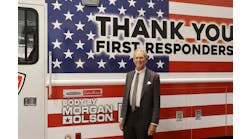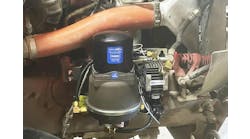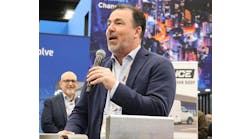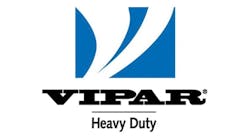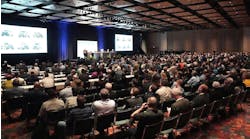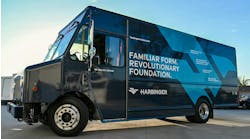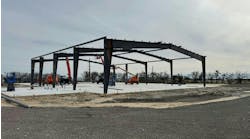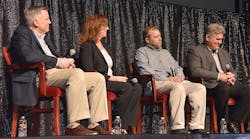Manufacturers are turning out trucks and trailers at an unprecedented pace, creating risk, opportunity—and plenty of business—up and down the supply chain, from component suppliers to distributors and dealers.
Then there are the folks actually deploying all this newfangled equipment.
Only nine months removed from seeing 2020, fleet managers face their own challenges, including figuring out how to maximize the latest technology, particularly when it comes to retaining employees, maintaining these high-tech tools, and minimizing downtime when there is a problem.
“One of the biggest things we have to worry about in our business is the driver, and ensuring they understand the technology,” said Brett Wacker, vice president of maintenance at Dart Transit Company in Minnesota. “We can put the best systems in the trucks and do all this fancy stuff, but if the operator can’t operate it, it means absolutely nothing, and all it becomes is a nuisance.
“We’ve helped ourselves with the technology on the telematics side, but we’ve yet to fully understand the ramifications of the technology on the driver side, with the operator who has to do it every day.
“So we have room to grow there.”
Wacker dished on these topics and more during Heavy Duty Aftermarket Dialogue 2019 in Las Vegas, Nevada, joining Mike Palmer, vice president of fleet services at Estes Express Lines, a large LTL carrier with a growing $3 billion operation; Gloria Pliler, director of parts purchasing for Daseke, which holds 22 flatbed and specialty haulers under its umbrella; and Lee Quinn, maintenance director at Point Ready Mix, for “A Frank Fleet Discussion—Outsourcing Service Shops and Parts Inventories.”
Together, they boast 130 years of experience—and manage more than 21,000 trucks and 48,000 trailers.
“This is the real world,” said Stu MacKay, president emeritus of MacKay & Company, who moderated the question-and-answer session. “These are the people charged with implementing the products, services and technology—and making it work profitably and economically in their operations.”
Here are summarized highlights from their hour-long discussion.
Good news, or bad? Palmer said, overall, today’s advancements have been good for the industry. The trucks are safer, fuel mileage is up, and they aren’t spewing black smoke anymore. But carriers are paying the price in terms of the complexity of equipment, and the cost of components. He, too, said training drivers on new and old equipment, and trucks from multiple manufacturers, is a growing challenge, perhaps requiring more input from OEMs and suppliers. He’d like to see audible, Q&A-type tutorials based on a truck’s VIN number embedded inside every cab.
Are the trucks reliable? Wacker believes they are, but tolerance for downtime is lower, complicating his ability to retain drivers who can use their smart phones to look for a new job before leaving his office. Palmer said diagnosing fault codes is a challenge for technicians, and many “mom-and-pop” shops aren’t able to work on new trucks. “The best truck is the one our mechanics can work on,” Palmer said.
Are AMTs automatically attractive? It depends on who you’re asking. Many young drivers can’t operate manual transmissions, Palmer said, so foregoing trucks with automated manual transmissions (AMTs) could be a barrier in attracting and retaining new drivers. Three years ago, Dart couldn’t give them away, Wacker said, and now no one wants to drive a manual, leading to a new problem—how to decide who gets to drive each truck.
“We’re trying to figure out that whole game, and figure out what we need to do to promote more manuals, because I can’t invest the capital it’s going to take to swap out two-thirds of the fleet in a very short period of time,” Wacker said. “And if it starts hindering our recruiting or retention, that’s going to be a problem.”
The majority of Ready Mix’s trucks are manuals, which perform better in off-road applications, and also seem to save the trucks from damage, vs. the ones they have with AMTs, Quinn said. And there still are plenty of older, more experienced drivers who prefer manual transmissions, and the greater control they provide.
What’s the maintenance like? As the cost of maintaining emissions systems increased, some large fleets abandoned local cleaning options in favor of aftermarket or remanufactured replacement parts. Palmer said he dealt with this at Estes, with every location doing its own thing, but it didn’t work well, so they streamlined processes across the company and settled on a limited group of suppliers who do their cleaning and replacement, but technician training still is an issue.
Dart also standardized maintenance, Wacker said, but the trick is maintaining all the different emissions systems in their fleet, from EGR (exhaust gas recirculation) valves to diesel particulate filters (DPFs) and SDR (selective catalytic reduction) systems. Fortunately, the company, and today’s OEMs, are more educated on emissions controls, after enduring the evolution, and fuel economy is on the rise.
“Through the cleaning processes, we’ve identified best practices and established that as a standard protocol across all of our facilities … so we don’t have the ‘rogue’ situation happening, where somebody thinks they can do it better, cheaper and it ends up costing us,” Wacker said. “So standardization is key.”
However, even if techs are educated and fault codes are diagnosed, maintenance directors still have headaches if the backlog affecting truck and trailer OEMs extends into the aftermarket. “One of the things I’ve noticed with the new equipment, and the technology behind it, is a lot of things are on back order,” Quinn said. “So even if we were aware we could fix it, we don’t have the parts.”
Who does the repair? When a truck brakes down outside of Daseke’s network, Pliler must consider many factors. Can the nearby mom-and-pop fix the truck, can the problem wait until the truck reaches Daseke’s nearest shop, or does it need to go to a dealer? If they can’t correct the issue in their shop, they’d rather go to a dealer, she said. The last option is the mom-and-pop, which may not be able to work under warranty.
Estes’ goal is to have trucks back up in two hours. If the check engine light is on, they’ll probably tow it to the closest destination terminal, then go to work fixing the truck as soon as it’s unhooked. Dart’s priority is to get broken-down trucks off the side of the road as quickly as possible. With today’s distracted drivers, any roadside breakdown is dangerous, no matter how careful is the trucker.
Ready Mix also wants its trucks running again in two hours, but because its product is concrete, which can’t sit long before they have a problem. The company has equipment that can turn the mixer barrel if the truck’s not running, but that’s a temporary solution, so they have arrangements with local wreckers, who know if his company calls, they’re under the gun.
How do techs stay current? OEMs today are good about providing training courses, Wacker said, and his company makes self-improvement part of the review process, while making sure access to ongoing education is available through multiple channels, including online courses and off-site training.
“As a fleet, we can’t pay the top dollar, compared to what a dealership can pay,” Wacker said. “We don’t have the labor rate we can pass on, because it’s all internal, so what we’ve got to do is provide a quality of life, and life-work balance, in order to retain technicians and office personnel.”
OEM- and vendor-supplied training is invaluable for smaller fleets, Quinn said. When the cost of buying advanced equipment, and then teaching the techs how to diagnose and maintain it, reaches a certain point, it’s cheaper for his company to outsource the maintenance than try to fix it themselves.
What about the data? Quinn said access to telematics data still is a problem, and with his technicians learning as they go, sometimes it’s a challenge to accurately communicate what are the issues. But exactly how this information will be shared across the supply chain is yet to be determined. Palmer said Estes is willing to share the data it mines from its trucks and trailers—to a certain extent—and in some ways that’s already happening, in regard to fuel-mileage data and fault codes.
Dart doesn’t share all its telematics information, but will allow district service managers limited access, to look up specific VIN numbers when a truck’s down, or to help in identifying trends. He says the industry still must figure out who owns all the data, but truck OEMs already have it, Pliler said.
Vendor relationships are key. Pliler said Daseke looks for national suppliers and manages parts delivery through direct-ship or over-the-counter programs. Their challenge is setting up a structure that ensures better coverage in Canada, preferably similar to the one they enjoy with top suppliers in the US. Ready Mix, with a much smaller fleet, doesn’t have the same reach, but relationships with local dealers and vendors are equally important, and loyalty is the key to negotiating elite parts pricing and availability.
Promoting parts compliance. Pliler starts with showing each carrier how much it can save by adopting a particular program, which typically provides enough incentive, but Daseke still is working on standardization. Wacker said he went through a similar process with Dart. Now all standard preventative and break-in parts prices are negotiated centrally, then they use vendor dealers to distribute parts. They don’t direct ship. All available parts are locked down in Dart’s parts catalog, and no one in the field can enter new parts in the catalog, so they can’t buy unapproved parts because they can’t pay the vendor.
Estes also standardized across its shops, which promotes consistency and also simplifies training. However, if there is a truck-down situation, and one part outside the company’s regular inventory will have the truck back up that day, mangers have the authority to buy locally. Maintenance parts direct-ship to individual locations.
“When we buy new equipment, I would like for the OEM guys to provide parts for it and say, ‘Look, first year, you’re going to need these things,’ and then second year, third year, fourth year, you’ll need this, because it’s a struggle to know what to put in stock when you’re running multiple trucks,” Palmer said.
